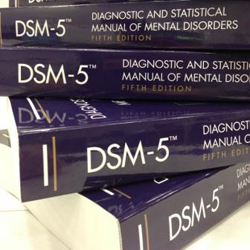By Kelly Patricia O’Meara
October 15, 2015
The National Institute of Mental Health (NIMH), which receives billions of taxpayer dollars in funding for “mental health research,” was behind a firestorm of controversy in 2013 when its Director, Thomas R. Insel, rocked the psychiatric community by publicly exposing the complete lack of science behind psychiatric diagnosing, which has lead to an epidemic of “mental illness” in the U.S.
Now, with the announcement of Insel’s November 1st departure from NIMH, a brief look at Insel’s 13-year tenure at NIMH seems appropriate. And, perhaps, some thoughtful consideration is in order of what mental health information should be disseminated to the public by Insel’s replacement.
Insel will be remembered for accurately describing what many believe is the fraud of psychiatric diagnosing, as presented in the Diagnostic and Statistical Manual of Mental Disorders (DSM-5). Insel boldly revealed the lack of science to support any psychiatric diagnosis when he explained, “While the DSM has been described as a ‘Bible’ for the field, it is, at best, a dictionary, creating a set of labels and defining each.”
Insel further clarified that the DSM’s “weakness is its lack of validity…. Unlike our definitions of ischemic heart disease, lymphoma, or AIDS,” said Insel, “the DSM diagnoses are based on a consensus about clusters of clinical symptoms, not any objective laboratory measure.”
Put simply, Insel explained what has long been known within the psychiatric/medical community: there is no known abnormality in the brain that is an alleged psychiatric disorder and, therefore, there are no tests available for diagnosing one.

The DSM’s “weakness is its lack of validity…. Unlike our definitions of ischemic heart disease, lymphoma, or AIDS, the DSM diagnoses are based on a consensus about clusters of clinical symptoms, not any objective laboratory measure.” — Thomas Insel
Rather than continuing to rely on the subjective diagnoses provided by the psychiatric industry, Insel, instead, devoted the considerable financial resources of NIMH (over one billion dollars every year) on “mapping the cognitive, circuit and genetic aspects of mental disorders….”
But this costly and lengthy strategy is as scientifically dubious as the DSM and where Insel’s biological brain abnormality hypothesis falls apart. For Insel’s strategy to work, a patient must first be diagnosed with a subjective psychiatric diagnosis, which he openly admits “lacks validity,” before the “mapping” can begin.
To augment, but not dispose of DSM, Insel began the Research Domain Criteria (RDoC) project to develop a “research classification system for mental disorders based upon dimensions of neurobiology and observable behavior.”[1] In 2014, the new Acting NIMH Director, Bruce Cuthbert, a clinical psychologist, began running RDoC.[2] The two authored an article in BMC Medicine in 2013, describing how “Psychiatry lags behind other areas of medicine in building avenues toward a precision medicine approach to diagnosis, and will not catch up until a system is available that reflects recent progress in genetics, other areas of neuroscience and behavioral science.” [3]
However, Insel fails to address issues that are problematic in the quest to identify alleged mental disorders as brain abnormalities, including the fact that most patients have had their brains chemically altered by psychiatric drugs.

Nearly 80 million Americans are taking at least one psychiatric drug, including over 1 million 0-5 year olds.
With nearly 80 million Americans taking at least one psychiatric drug, the mapping of patients with chemically unaltered brains becomes significantly more difficult. And it is with these drug “treatments” where Insel has failed to be more forthcoming with the public.
Take, for example, the recent study which found that young people between the ages of 15-24 were nearly 50% more likely to commit violent crimes while taking antidepressants, compared to those not taking the drugs. The study, published in PLoS Medicine, was based on information gathered on more than 850,000 individuals who had been prescribed SSRI (Selective Serotonin Reuptake Inhibitor) antidepressants.
Despite receiving wide coverage by the major news organizations, Insel, the Director of the world’s premier mental health research organization, remained silent on the breaking news. Insel was equally silent on another recent study, which exposed the fraudulent research of GlaxoSmithKline’s antidepressant, Paxil. According to a review of the data, Paxil is not effective in the treatment of children and there is significant risk of suicide associated with the drug.
Insel’s silence on such important issues begs serious questions for the incoming director. If the mission of NIMH is to “transform the understanding and treatment of mental illnesses,” shouldn’t that include providing the public with updated, accurate information about harmful drug “treatments?” And to be informed that there is no known cause of, or cure for, mental disorders, nor a valid diagnostic system to even identify them. After 66 years in business, and tens-of-billions-of-dollars appropriated, the research produced at NIMH has failed to identify a single biological cause of even one alleged psychiatric mental disorder.
Researchers at NIMH have their hands full with lofty, if not insurmountable, goals like “mapping” brain circuitry. After all, discovering, for example, a biological cause for the alleged mental disorder, Major Depression, is, well, probably as difficult as finding a biological cause for major happiness.
In the meantime, as one NIMH director departs, the question for the incoming director is: should the federal agency’s efforts be strictly focused on such faulty science, rather than informing the public of what is known? The in-coming director will need to be honest about making the public aware of the on-going nebulousness of psychiatric diagnosing and the ever-increasing dangers associated with the psychiatric drugs and other mental health “treatments.”
Kelly Patricia O’Meara is an award-winning former investigative reporter for the Washington Times’ Insight Magazine, penning dozens of articles exposing the fraud of psychiatric diagnosis and the dangers of the psychiatric drugs—including her ground-breaking 1999 cover story, “Guns & Doses,” exposing the link between psychiatric drugs and acts of senseless violence. She is also the author of the highly acclaimed book, Psyched Out: How Psychiatry Sells Mental Illness and Pushes Pills that Kill. Prior to working as an investigative journalist, O’Meara spent sixteen years on Capitol Hill as a congressional staffer to four Members of Congress. She holds a B.S. in Political Science from the University of Maryland.
References:
[1] Bruce N Cuthbert and Thomas R Insel. “Toward the future of psychiatric diagnosis: the seven pillars of RDoC,” BMC Medicine, 2013, 11:126 doi:10.1186/1741-7015-11-126; http://www.biomedcentral.com/1741-7015/11/126
[2] http://www.nimh.nih.gov/about/bruce-cuthbert.shtml
[3] Bruce N Cuthbert and Thomas R Insel. “Toward the future of psychiatric diagnosis: the seven pillars of RDoC,” BMC Medicine, 2013, 11:126 doi:10.1186/1741-7015-11-126; http://www.biomedcentral.com/1741-7015/11/126




SHARE YOUR STORY/COMMENT